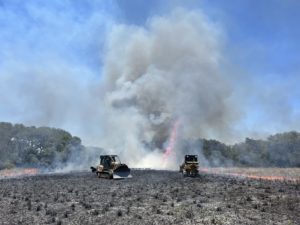High wildfire potential continues with drought and heat
Texas A&M Forest Service warns large wildfires possible July 12
Hot and dry conditions across Texas will create high wildfire potential through the weekend.

Continued triple-digit temperatures and dry conditions will reduce the moisture in vegetation across the landscape, increasing the possibility for wildfire ignitions to occur this week.
On July 12, the fire environment will support an increased potential for large wildfires that are resistant to control near Wichita Falls, Fort Worth, Waco, Austin, San Antonio, San Angelo and Abilene. Portions of East Texas may be susceptible to large wildfires for areas near Athens, Tyler, Longview, Palestine and Huntsville.
“An added complexity to the fire environment this week is the potential for thunderstorms,” said Luke Kanclerz, Texas A&M Forest Service fire analyst. “Wildfire ignitions due to lightning will be possible because of the underlying drought and vegetation dryness. Increased wind speeds from nearby thunderstorms can cause a sudden increase in fire activity, creating safety concerns for firefighters.”
Wildfire response
State and local resources have been busy over recent weeks with wildfire response. Over the past 10 days, Texas A&M Forest Service resources have responded to 98 wildfires that burned 17,763 acres across the state. This includes 43 new wildfires from July 8-10.
Firefighters continue suppression efforts on several wildfires burning across the state, including the Blanket Fire in Brooks County, 5,900 acres and now 70% contained; Spade Ranch Fire in Mitchell County, 500 acres and now 50% contained; Hard Castle Fire in Bosque County, 540 acres and now 70% contained; and Deerhead Fire in Baylor County, 500 acres and 75% contained.
Texas A&M Forest Service continues to monitor the situation closely and has positioned personnel and equipment across the state for a quick and effective response to any requests for assistance.
“With persistent hot and dry conditions as well as an intensifying drought, many recent wildfires have required more time and resources to fully contain,” said Wes Moorehead, Texas A&M Forest Service fire chief. “The job of our state and local firefighters becomes more difficult and dangerous under these circumstances. We need Texans to be cautious of any activity that causes sparks and may ignite a wildfire.”
Prepositioned resources
Fully staffed task forces and additional suppression equipment are staged across East Texas and in Amarillo, Beeville, Brownwood, Burkburnett, Childress, Edinburg, Fort Stockton, Fredericksburg, Greenville, Lubbock, Marble Falls, McGregor, Merkel, Mineral Wells, Ozona, San Angelo, Smithville, Sweetwater, Uvalde and Victoria.
Fireline supervisors, command staff and incident commanders with advanced qualifications are also strategically placed across the state to respond. Additionally, 391 personnel from 33 states are in Texas to support wildfire response efforts.
Aircraft continue to be a beneficial asset in supporting suppression efforts on the ground, aiding in the protection of structures and other valuable resources.
Thirty-six aviation aircraft are staged in state, including five large air tankers, 12 single engine air tankers, six air attack platforms, five Type 1 helicopters, two Type 2 helicopters and four Type 3 helicopters.
Three strike teams, which include 42 personnel and 10 engines, have been mobilized via Texas Intrastate Fire Mutual Aid System, TIFMAS, and are currently assigned to wildfires.
Stay wildfire aware. If a wildfire is spotted, immediately contact local authorities. A quick response can help save lives and property.
For current conditions and wildfire outlook, visit the Texas Fire Potential Outlook https://bit.ly/3kemhbG.
Texas A&M Forest Service does not own any aviation resources but instead uses federal aviation contracts through the U.S. Forest Service and Bureau of Land Management for all firefighting aircraft.


